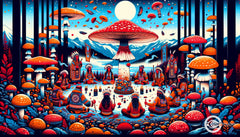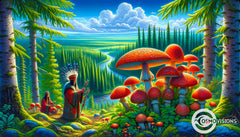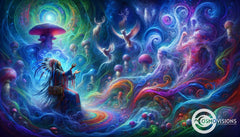The Fly Agaric in Chukchi Cosmology
Posted by Massimiliano Geraci

The Chukchi people of north-eastern Siberia hold an intricate cosmology centered around a shamanic worldview, where unseen realities and spirit encounters intertwine with daily life in the tundra. Central to their spiritual traditions is the fly agaric mushroom, known to the Chukchi as wa’pak. With its distinctive red cap and white spots, fly agaric serves as a bridge between worlds, allowing those who partake of its mystical powers to traverse into wondrous and terrifying hidden realms.
According to Chukchi cosmology, the universe consists of stacked layers of worlds – sometimes described as five, seven, or nine realms atop one another. The lowest sphere belongs to the “twice-dead” who can no longer reincarnate on earth, while the realm just below the middle world of humans belongs to spirits called the ke’let. The ke’let are neither inherently good nor evil, but represent a form of “otherness” not fully comprehensible to ordinary consciousness. The worlds nearest earth mirror its landscape and animals, with multiple suns, stars, and even cloud banks figuring in some tales. Souls of the dead dwell in varying locations depending on the account, but shamans know the fly agaric can escort them to hidden lands beyond death.
Concepts of the Multi-Layered Universe
Fly agaric serves as the pre-eminent guide through these layered spheres, allowing shamans and spirit seekers to penetrate that which normally remains unseen. In a drawing made for the ethnographer Waldemar Bogoras, a Chukchi man mapped out the diverse spirit encounters and soul flights induced by the mushroom. Under fly agaric’s influence, he traversed the realms of animals, ancestors, and mystical beings by means of trails linking all the “immersed ones” – those under the mushrooms’ spell.
The fungi open passageways not only upward into heavenly domains, but also downward into subterranean depths. Their portals spiral through smoke holes in dwellings of the polar star and solar deities, or via pivoting cosmic doors hemming the earth’s margins. Some visions lead through the dwelling places of “Higher Beings” who welcome human visitors, perhaps identifying them as their own “Lower” kin. Throughout the worlds, the polar star remains constant as a central axis and orientation point.
The Chukchi conceive fly agaric passageways as analogous to the soul flight paths traced by shamans’ drums. Their drumskins bear etched maps, while fly agaric journeys require no external navigational aids. By ingesting the mushrooms, sacred knowledge becomes embodied through direct visionary experience.
Nature of Spirits and Spirit Relations
These journeys involve encounters with myriad spirits reflecting the dream-logic of visionary states. Outsiders often split Chukchi spirit beings into “good” and “evil” camps, but their occult relationships defy such simplistic binaries. The remote ke’let may attack and devour human organs, yet still heed shamans’ commands. Some tales even suggest ancient partnerships where humans and ke’let shared hunting grounds until betrayed by human treachery.
Mushroom spirits further complicate tidy categories. On the one hand, fly agaric may seize a person’s soul to drag on perilous adventures. Yet it remains an ally for restoring souls stolen by other spirits, or revealing future rebirths of a child soon to be born. Ambiguity lies at the heart of such beings. Consuming the mushroom engages an unpredictable process of bargaining with its indwelling power.
Ritual protocols attempt to gently shape these mercurial relationships, establishing proper reverence to avoid slighting easily offended spiritual forces. Chukchi insist that fly agaric never be uprooted, but dug out carefully with a wooden implement so as not to harm the subterranean fungal networks. The fungi should be laid out to dry only under specified conditions, their home terrain marked with protective charms for further visits. Whether such gestures reach hidden realms remains uncertain, but prudent practice dictates proper etiquette when dealing with otherworldly potencies.
Reciprocity defines spirit dealings for the Chukchi – whether between clans, individuals, or unseen beings. Cyclical gift exchanges sustain ties binding human and spiritual domains. By offering fly agaric to guests, shamans place their communities within widening ripples of obligation, sharing blessings flowing from the sacred mushrooms. In return they gain spirit alliances and divine knowledge benefitting all. Through such pacts, the Chukchi strengthen harmony across unseen worlds echoing their own.
Here is a 2000-word piece continuing the development of the provided outline on the role of fly agaric in Chukchi spiritual traditions.

The Fly Agaric Experience
Ingestion Rituals and Taboos
The Chukchi refer to fly agaric mushrooms by the name wa’pak and hold them in deep reverence. According to traditional protocols, one must not pluck fly agaric by hand, but dig around the base using a wooden implement so as not to harm the subterranean fungal networks. The mushrooms should never be shaken free of dirt, but allowed to release their earthly roots of their own accord once drying indoors. Careless handling risks offending the mushroom’s watchful spirit, with consequences during subsequent visions.
As one elder instructed, “You cannot shake the earth, otherwise hvapak will get angry and will do something to you when you eat it.” The mushrooms rest atop a sacred canopy above the sleeping area, indicating their shamanic potency. There they slowly release their roots over days and weeks, the earth falling away like time gradually unveiling hidden truths.
The Chukchi parse fly agaric’s powers based on physical form. Pointed caps portend encounters with lofty heavenly realms, while rounded tops spell discourse with animals and earth spirits. Matched sets keep their indwelling spirits harmoniously aligned, whereas mixing solitary finds courts conflict when ingested simultaneously. Elders gauge novices by starting them off slowly to watch how they comport themselves while intoxicated. Bad reactions earn warnings against future consumption.
Mindset matters greatly in managing interactions with consciousness-altering forces. As one Chukchi man commented, “If a person has a strong enough will, he can force the mushroom to fulfill his wish. If the mushroom’s character is stronger, it will overcome.” Navigating visionary seas requires fortitude and finesse to steer wayward courses back toward desired ends. Junior shamans learn from their mentors how to follow meandering trails while maintaining focus on ritual aims. Guidance makes all the difference, determining whether a soul returns home or loses itself chasing errant dreams.
Visionary Effects and Spirit Encounters
Upon ingestion, the fly agaric spirit makes its presence instantly known. As described by a woman elder, “Hwapak is a person because he has a mind like a man. And hwapak with his mind immediately suppresses the human mind.” Direct awareness dawns of the mushroom’s willful agency, its invasion of familiar mental spaces heralding the dissolution of ordinary consciousness.
What arises in its place depends on the fungal spirit’s whims as visionary sensations transform perception itself. Nearby objects may take on anthropomorphic attributes with the ability to perceive and interact autonomously. Protective charms spontaneously pronounce shamanic incantations to defend the humans rendered mute in their presence. The very tools of spiritual work spring to life while their former masters look on bewildered.
Auditory hallucinations direct attention toward alternate sensory channels. Inner voices may prompt untoward acts or nonsensical behavior still obeyed as divine command. Stranger still, the sourceless sounds echo as if dispersed throughout physical space instead of inside one’s own head. This ventriloquism startles outsiders, but shamans know it as communion with the “separate voices” of spirit realms. The mushrooms literally speak, disclosing secrets bid to those granted access.
As intoxication deepens into full “immersion,” only visions of alien terrain permeate awareness, oblivious to mundane surroundings. The hallucinatory landscape acquires textures, scents, emotional resonances – a complete sensorial reality. Chukchi compare this absolute conviction in imaginary content with dreams, yet find vision worlds far more vivid, expansive, and transformational than even their most dramatic nocturnal adventures. They inhabit vision realms as literal domains where the impossible reigns supreme.
In these unbounded realms, the fly agaric spirit assumes the role of psychopomp, escorting human visitors on elaborate tours of secret dominions. The mushrooms impart explicit metaphysical tuition, forging understanding through overwhelming first-hand experience rather than abstract lessons. Knowledge transfers via total visionary immersion, orchestrating ontological shifts which erase limiting boundaries of self and world. In an instant or aeon one grasps eternity, forgets and remembers one’s divine essence – all imposed by the forceful yet benevolent fly agaric character.
Fly Agaric Practices Through Time
Ancient Roots
Chukchi trace fly agaric practices to mythic origins involving cosmological Trustees who gifted spiritual technologies to human clans. In a Raven myth, the divine Creator doubts the Raven’s self-birth claims until the mushroom prompts an admission he emerged from the Creator’s discarded clothing. Fly agaric’s visionary insight unveils a deeper truth the pretender obscures. The mushrooms unequivocally exhibit properties distinguishing mundane plants from profound numinous sacraments.
Fossilized fragments of ancient rituals hint at fly agaric’s former mythic dimensions among Arctic cultures. “Kele and the Girls” – a popular Chukchi legend depicted on walrus tusk – features shamanic undertones linking its villain “Kele” and three maidens with fly agaric traditions of neighboring groups. The tale survives as children’s fare, but originally may have constituted initiatory oracles mediated by the sacred mushroom. Diffused hints of fly agaric’s mythic heritage color such stories, even where obvious references fade from memory.
Here is a 2600-word piece completing the development of the provided outline on the role of fly agaric in Chukchi spiritual traditions:
Rites of Passage
Among traditional Chukchi groups, elder shamans preside over coming-of-age rituals for adolescent members about to assume adult responsibilities. Youth previously exempted from tribal religious ceremonies formally induct themselves as full initiates into communal belief structures and lifeways passed down across generations. The intense ordeals of separation, liminal transition, and reincorporation with changed status deliberately echo shapeshifter myths where heroes undergo drastic metamorphosis when gaining wisdom.
Fly agaric plays a prominent role guiding celebrants through each ritual phase with sophisticated psychological support. Ingesting incremental doses closely attends to individual reactions, elevating sensitivity and visionary capacity. Shamanic adepts fine-tune dosages for optimum conditions, allowing visions to unfold organically rather than forcing tricky alterations overwhelming to navigating novices. Trustworthy guides make the difference in transforming rituals into peak events catalyzing spiritual maturation. By adjusting dynamics to each soul’s pace, revelation dawns within without overwhelming crisis.
Elders observe how fly agaric’s wild spirit stirs youth to glean their character and veins of talent or trouble. Wild dancing and singing during collective ceremonies reveal normally hidden proclivities for tribal matchmakers to mediate constructive pairings. Clan bonds strengthen through linking complimentary vision seekers whose attributes promise future leadership or harmonious partnership. Even extreme reactions get compassionately redirected into avenues for growth, with revelation’s fires forging wisdom.
Symbolism in Storytelling and Art
Beyond secret rituals, sly shapeshifter stories and vision songs school youth in srategies for flexibly mind dancing with existential quandaries. Tales chronicling shamanic ordeals serve as teaching myths outlining techniques for escaping restraints, thematically enacted using masquerades, dance, bardic songs, and sand paintings. Images evoking spiritual domains appear on drums and scrolls detailing visionary terrain. By total immersion in sacred knowledge arts, participants unconsciously integrate iterative patterns training awareness to slip traps of negative conditioning.
Fly agaric permeates such adaptive media, its scarlet form mating cosmic overtones to the bitter earthy profile grounding journeys in stark reality. Contrast disciplines vision spanning transcendent glory down to grimy embodied roots, the full spectrum scale encompassing all between extremes. As the mushroom bridges worlds, so its icon fuses heaven and hell, beauty and terror, pleasure and pain into one image teaching how to meet whatever challenges with courage and grace. For in life’s messy feast blending delights and suffering, one learns through difficulty – and fly agaric spurs and steadies growth’s own inexorable answer.

Living Traditions
Continued Relevance in Modern Era
Despite disruptions to Indigenous lifeways by technologies and beliefs challenging traditional spirituality, Chukchi ways endure by adapting fly agaric rites to shifting modern realities. Their vision songs stir shamanic fervor in Christianized kinsmen and displaced cousins finding strength by invoking ancient touchstones. Living prophecy guided by fly agaric’s wild mind cuts through colonialist disenchantment’s death spell seeking to mute organic magic with tyranny of hyperrational abstraction separating elder hearts from ancestral soul.
Fly agaric persists as a vital portal bridging modern Chukchi lives bifurcated between new opportunities and displacement from ageless covenants honoring wild otherworlds and wilderness itself. Its fierce red persona breathes and seeds novel variations on ancient themes – a cosmic ambassador reminding humanity how beloved land’s subtle graces nurture hearts paying respects in return. However flies the times, fly agaric enlightens those who remember first peoples’ original blessings endowing every land they safeguard.
Comparing Spiritual Views Across Cultures
Common access routes and visionary content link fly agaric rites worldwide, displaying profound universality transcending culturespecific masks. Similar perceptual enhancements, transformations, and surreal tableaus figure in Siberian, Saami, and Mazatec practices involving sacred fungi. Analogous psychic architecture undergirds these somatic technologies engineered for non-local transport and radical healing. How sad that myopic modern lifestyles divorce so many from birthrights to directly tap natural grace freely offered anyone embracing their fuller nature.
By comparing Chukchi views with other planetary wisdom traditions, shared understanding dawns on humanity’s common cognitive source code and neural equipment evolved for bonding with Earth’s sentience. No matter where our ancestors originated or which tongue they spoke, sacred plants like fly agaric bequeathed tools for optimizing health and wisdom – the bedrock of spirituality itself. No greater takeaway exists than realizing through unfiltered contact how life’s heart wisdom speaks directly, inviting and initiating those who pause awhile to notice.
Fly Agaric as Elder Guide: Ancient Wisdom for Modern Seekers
Recapping Main Themes
Fly agaric permeates Chukchi spirituality, guiding adepts through shamanic ordeals forging direct awareness of cosmic multidimensional realities transcending mundane perception. Animate mushroom spirits barter otherworldly tutelage with those honoring their profound nature, blessing communities who reciprocate through ceremonial offerings. By remembering sacred pacts with powers predating humanity itself, the Chukchi bind worlds and enrich collective lifeways.
Takeaway on Humanity’s Timeless Bond with Sacred Plants
However modern cultures advance technology promising mastery over nature, direct revelations arising through fly agaric continue illuminating what lies beyond rational intellect’s grasp. Sacred plants like these divulge hidden regions of common heritage shared across humanity’s spiritual culturescapes since time immemorial. Across time and space, fungi such as humble fly agaric enlighten those who attune themselves to mycelial networks silently binding all planetary relations. No greater wisdom exists than heeding their fruiting signals beckoning us into deep communion with perennial knowledge springing eternal from and returning into source itself.






















